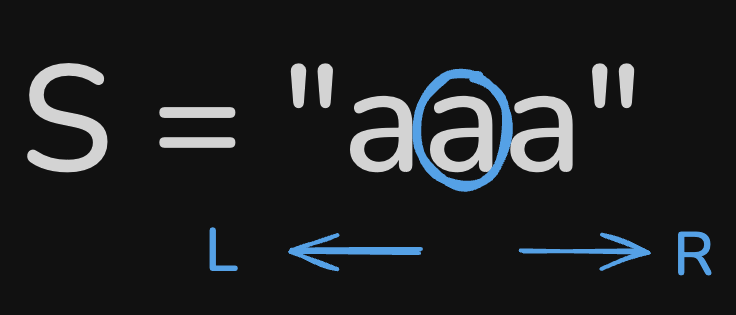Palindromic Substrings
Problem
Given a string s, return the number of palindromic substrings in it.
A string is a palindrome when it reads the same backward as forward.
A substring is a contiguous sequence of characters within the string.
Examples
Example 1:
Input: s = "abc"
Output: 3
Explanation: Three palindromic strings: "a", "b", "c".
Example 2:
Input: s = "aaa"
Output: 6
Explanation: Six palindromic strings: "a", "a", "a", "aa", "aa", "aaa".
Solution
Video explanation
Here is the video explaining below methods in detail. Please check it out:
<div class="youtube-embed"><iframe src="https://www.youtube.com/embed/JI0Y6CfDQ9U" frameborder="0" allowfullscreen></iframe></div>
Method 1 - Brute Force
Create all substrings, by nested looping and check if the strings are palindrome or note.
Time complexity for generating substring is O(n^2) and checking palindrome is O(n), hence time complexity is O(n^3).
Method 2 - Going Outward on Each Index and Check for Palindrome
We have solved similar problem - [Longest Palindromic Substring](longest-palindromic-substring).
For each char, we will go 1 to left and 1 to right, if the chars match, that is 1 substring:

For eg. s[1] is palindrome, as it is just 1 char. Now, we go left or right. As, s[0] and s[2] are same chars, s[0:2] is now a palindrome as well. But this approach gives us odd length palindrome.
To, get even length palindrome, we have to take 2 chars, with left pointer being L and Right pointer being L+1.

Code
Java
class Solution {
public int countSubstrings(String s) {
int ans = 0;
int n = s.length();
char[] arr = s.toCharArray();
int l,r;
l = r = 0;
for (int i = 0; i < n; i++) {
// odd length
l = r = i;
while(l >= 0 && r < n && arr[l]==arr[r]){
ans += 1;
l--;
r++;
}
// even length
l = i;
r = i + 1;
while(l >= 0 && r < n && arr[l]==arr[r]){
ans += 1;
l--;
r++;
}
}
return ans;
}
}
Python
class Solution:
def countSubstrings(self, s: str) -> int:
ans = 0
n = len(s)
arr = list(s)
for i in range(n):
# Odd length
l = r = i
while l >= 0 and r < n and arr[l] == arr[r]:
ans += 1
l -= 1
r += 1
# Even length
l = i
r = i + 1
while l >= 0 and r < n and arr[l] == arr[r]:
ans += 1
l -= 1
r += 1
return ans
Complexity
- ⏰ Time complexity:
O(n^2)for nested loops. - 🧺 Space complexity:
O(n)for storing results.
Method 3 - Using DP
Here is the approach:
- DP Table:
dp[i][j]isTrueif the substrings[i:j+1]is a palindrome.- Otherwise,
dp[i][j]isFalse.
- Base Cases:
- Substrings of length 1 (
i == j) are always palindromes, so we initialisedp[i][i] = True. - Substrings of length 2 (
s[i] == s[i+1]) are palindromes if both characters are the same.
- Substrings of length 1 (
- General Case:
- For substrings of length 3 or more,
s[i:j+1]is a palindrome if:- The first and last characters are the same:
s[i] == s[j]. - The substring in between (
s[i+1:j]) is also a palindrome:dp[i+1][j-1] = True.
- The first and last characters are the same:
- For substrings of length 3 or more,
Code
Java
public int countSubstrings(String s) {
int n = s.length();
boolean[][] dp = new boolean[n][n]; // DP table to track palindromic substrings
int count = 0;
// Base case: Single character substrings are always palindromes
for (int i = 0; i < n; i++) {
dp[i][i] = true;
count++;
}
// Base case: Two consecutive characters are palindromes if they are the same
for (int i = 0; i < n - 1; i++) {
if (s.charAt(i) == s.charAt(i + 1)) {
dp[i][i + 1] = true;
count++;
}
}
// General case: Substrings of length >= 3
for (int length = 3; length <= n; length++) { // length goes from 3 to n
for (int i = 0; i <= n - length; i++) { // Starting index of the substring
int j = i + length - 1; // Ending index of the substring
// A substring is a palindrome if its first and last characters match,
// and the substring without them is also a palindrome
if (s.charAt(i) == s.charAt(j) && dp[i + 1][j - 1]) {
dp[i][j] = true;
count++;
}
}
}
return count;
}
Python
def countSubstrings(s: str) -> int:
n = len(s)
dp = [[False] * n for _ in range(n)] # DP table to track palindromic substrings
count = 0
# Base case: Single character substrings are always palindromes
for i in range(n):
dp[i][i] = True
count += 1
# Base case: Two consecutive characters are palindromes if they are the same
for i in range(n - 1):
if s[i] == s[i + 1]:
dp[i][i + 1] = True
count += 1
# General case: Substrings of length >= 3
for length in range(3, n + 1): # length goes from 3 to n
for i in range(n - length + 1): # Starting index of the substring
j = i + length - 1 # Ending index of the substring
# A substring is a palindrome if its first and last characters match,
# and the substring without them is also a palindrome
if s[i] == s[j] and dp[i + 1][j - 1]:
dp[i][j] = True
count += 1
return count
Complexity
- ⏰ Time complexity:
O(n^2), since it iterates over each substring (nested loops). - 🧺 Space complexity:
O(n^2)for using dp array.